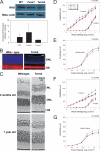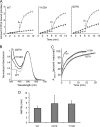Mutations of the opsin gene (Y102H and I307N) lead to light-induced degeneration of photoreceptors and constitutive activation of phototransduction in mice
- PMID: 20207741
- PMCID: PMC2863193
- DOI: 10.1074/jbc.M110.112409
Mutations of the opsin gene (Y102H and I307N) lead to light-induced degeneration of photoreceptors and constitutive activation of phototransduction in mice
Abstract
Mutations in the Rhodopsin (Rho) gene can lead to autosomal dominant retinitis pigmentosa (RP) in humans. Transgenic mouse models with mutations in Rho have been developed to study the disease. However, it is difficult to know the source of the photoreceptor (PR) degeneration in these transgenic models because overexpression of wild type (WT) Rho alone can lead to PR degeneration. Here, we report two chemically mutagenized mouse models carrying point mutations in Rho (Tvrm1 with an Y102H mutation and Tvrm4 with an I307N mutation). Both mutants express normal levels of rhodopsin that localize to the PR outer segments and do not exhibit PR degeneration when raised in ambient mouse room lighting; however, severe PR degeneration is observed after short exposures to bright light. Both mutations also cause a delay in recovery following bleaching. This defect might be due to a slower rate of chromophore binding by the mutant opsins compared with the WT form, and an increased rate of transducin activation by the unbound mutant opsins, which leads to a constitutive activation of the phototransduction cascade as revealed by in vitro biochemical assays. The mutant-free opsins produced by the respective mutant Rho genes appear to be more toxic to PRs, as Tvrm1 and Tvrm4 mutants lacking the 11-cis chromophore degenerate faster than mice expressing WT opsin that also lack the chromophore. Because of their phenotypic similarity to humans with B1 Rho mutations, these mutants will be important tools in examining mechanisms underlying Rho-induced RP and for testing therapeutic strategies.
Figures







Similar articles
-
Wheel running exercise protects against retinal degeneration in the I307N rhodopsin mouse model of inducible autosomal dominant retinitis pigmentosa.Mol Vis. 2019 Aug 21;25:462-476. eCollection 2019. Mol Vis. 2019. PMID: 31523123 Free PMC article.
-
Constitutive activation of phototransduction by K296E opsin is not a cause of photoreceptor degeneration.Proc Natl Acad Sci U S A. 1995 Apr 11;92(8):3551-5. doi: 10.1073/pnas.92.8.3551. Proc Natl Acad Sci U S A. 1995. PMID: 7724596 Free PMC article.
-
Constitutive "light" adaptation in rods from G90D rhodopsin: a mechanism for human congenital nightblindness without rod cell loss.J Neurosci. 2001 Aug 1;21(15):5449-60. doi: 10.1523/JNEUROSCI.21-15-05449.2001. J Neurosci. 2001. PMID: 11466416 Free PMC article.
-
Mechanisms of neurodegeneration in a preclinical autosomal dominant retinitis pigmentosa knock-in model with a RhoD190N mutation.Cell Mol Life Sci. 2019 Sep;76(18):3657-3665. doi: 10.1007/s00018-019-03090-9. Epub 2019 Apr 11. Cell Mol Life Sci. 2019. PMID: 30976840 Free PMC article.
-
Rhodopsin-associated retinal dystrophy: Disease mechanisms and therapeutic strategies.Front Neurosci. 2023 Apr 3;17:1132179. doi: 10.3389/fnins.2023.1132179. eCollection 2023. Front Neurosci. 2023. PMID: 37077319 Free PMC article. Review.
Cited by
-
Clinically Relevant Outcome Measures for the I307N Rhodopsin Mouse: A Model of Inducible Autosomal Dominant Retinitis Pigmentosa.Invest Ophthalmol Vis Sci. 2018 Nov 1;59(13):5417-5430. doi: 10.1167/iovs.18-25345. Invest Ophthalmol Vis Sci. 2018. PMID: 30452595 Free PMC article.
-
Mouse model resources for vision research.J Ophthalmol. 2011;2011:391384. doi: 10.1155/2011/391384. Epub 2010 Oct 31. J Ophthalmol. 2011. PMID: 21052544 Free PMC article.
-
Lessons learned from quantitative fundus autofluorescence.Prog Retin Eye Res. 2020 Jan;74:100774. doi: 10.1016/j.preteyeres.2019.100774. Epub 2019 Aug 28. Prog Retin Eye Res. 2020. PMID: 31472235 Free PMC article. Review.
-
Noninvasive Electroretinographic Procedures for the Study of the Mouse Retina.Curr Protoc Mouse Biol. 2018 Mar;8(1):1-16. doi: 10.1002/cpmo.39. Curr Protoc Mouse Biol. 2018. PMID: 30040236 Free PMC article.
-
Gene Therapy for Rhodopsin-associated Autosomal Dominant Retinitis Pigmentosa.Int Ophthalmol Clin. 2021 Oct 1;61(4):79-96. doi: 10.1097/IIO.0000000000000383. Int Ophthalmol Clin. 2021. PMID: 34584046 Free PMC article.
References
-
- Rim J., Oprian D. D. (1995) Biochemistry 34, 11938–11945 - PubMed
-
- Humphries M. M., Rancourt D., Farrar G. J., Kenna P., Hazel M., Bush R. A., Sieving P. A., Sheils D. M., McNally N., Creighton P., Erven A., Boros A., Gulya K., Capecchi M. R., Humphries P. (1997) Nat. Genet. 15, 216–219 - PubMed
-
- Toda K., Bush R. A., Humphries P., Sieving P. A. (1999) Vis. Neurosci. 16, 391–398 - PubMed
Publication types
MeSH terms
Substances
Grants and funding
LinkOut - more resources
Full Text Sources
Molecular Biology Databases
Research Materials

